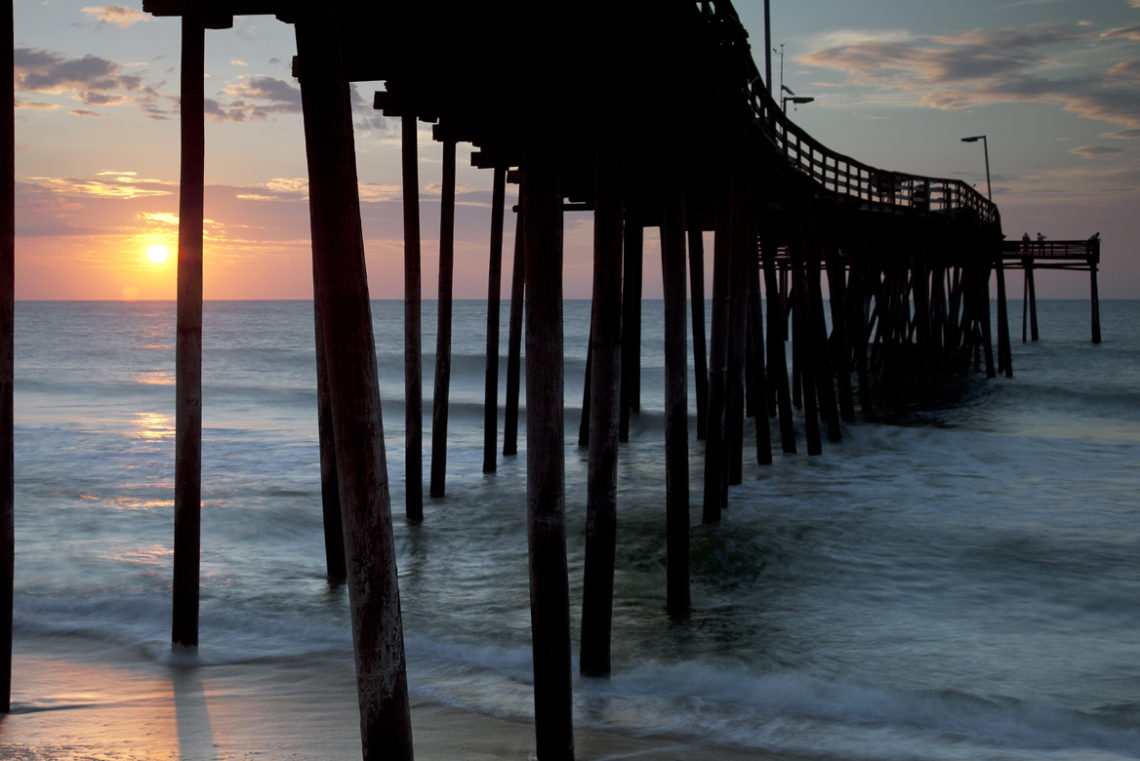
Thomas Yocum
When Europeans first landed on Hatteras Island, they found rich dark forests of live oak, dogwood, yaupon, wax myrtle and cedar. But 400 years have brought profound changes to the island. Logging, livestock, sand waves, storms and insects have combined to plague the forest leaving little trace of its early richness.
More than 150 years ago, children clambered across grapevines between the tops of ancient live oak trees and dropped into the ocean from vine swings. Forests covered large portions of Hatteras Island from surf to sound. It was a very different place.
"Fifty years ago on Hatteras Island, from inlet to inlet, a distance of over 40 miles, was completely covered with a prodigious growth of trees among which live-oak and cedar were chief in size and number," wrote John Spears, a Scribner's Magazine correspondent after an 1890 visit to Hatteras.
"Growing everywhere in this forest were grapevines of such great length and extent that the boys of that day -- the white-haired men of this -- were in the habit of climbing in the treetops and climbing from tree to tree, often for a distance of over 100 yards, on the webs the vines had woven."
The trees are gone. The result of a fateful chain of events that has changed Hatteras Island forever.
By the early 1820s, islanders began to realize the value of the forests around them. The live oak and cedars were important commodities for ship builders. Some of the wood was shipped to New England and shipyards on the North Carolina mainland, but most was used by Kinnakeet (Avon) shipbuilders who were famous for their small, sturdy schooners.
Slowly at first, and then quickened by the lure of fast profits, logging began to thin the forest canopies. Small gaps appeared and gradually grew in size. For the Hatteras Island forests, the gaps spelled disaster. Maritime forest canopies shield undergrowth from the ocean's salt spray. The undergrowth in turn stabilizes the soil under the trees. Without the trees, the exposed plants quickly withered under the harsh sun and spray. As the plants died, wind scoured the roots, whisking away the thin soil and exposing the sandy foundation of the island. No one could have imagine what was to come next.
"Where the green trees had stood in the sandy loam, a sand-ridge arose, which, receiving the breath of life from the northeast gale, started on a mission of death," Spears wrote. "It's speed of travel increased with every year, for every inch that was added to the narrow sandy desert along the sea increased the area on which the wind could get a firm hold of the sand. Foot by foot, yard by yard, rod by rod the wave traveled inland."
The sand waves -- some as tall as Jockey's Ridge, the 100-foot high dune in Nags Head -- towered over parts of Hatteras Island. Word of what was happening on Hatteras soon spread and the country began to take notice, sending correspondents such as Spears, and scientists such the renowned Collier Cobb to see the great dunes.
"The strong winds pile the sands into great barchanes or medanos, crescentic sand dunes known locally as whaleheads, which are moving steadily southward," Cobb wrote in a 1906 National Geographic article. The towering waves moved steadily across the island; winds lifting the loose sand and allowing it to settle around the trunks of live trees in the wave's path. Nothing was spared. Houses, fences, roads and cemeteries were covered by the enormous piles of sand. As the waves marched forward, pushed by the prevailing wind, they left a trail of destruction in their wake. Skeleton forests of still-standing tree trunks cast eerie shadow over the bleached bones uncovered from the island's cemeteries.
Many of the areas covered by the sand waves have never recovered. New trees that managed to find a bit of useful soil amidst the desert-like conditions were quickly devoured by the free-ranging livestock turned loose across the island. The animals -- pigs in particular -- cleared live oak saplings and acorns. Fast-growing pines, more adapted to the sandy soil, soon began to dominate the landscape.
Penning laws were enacted in 1937 to protect the plants and grasses that were being planted by the Civilian Conservation Corps as part of the dune construction project on Hatteras. But alien plant species introduced by federal project managers altered the landscape even more, challenging the oaks for what little sunlight was left.
It would take more than 50 years until the island's live oaks finally had a chance to recover. In 1993, Hurricane Emily raked Hatteras, leveling nearly a third of the now-dominant pines and crippling even more. The weakened trees were gobbled by up hungry beetles, one of their natural predators. Exploding populations of southern pine and Ips beetles devoured many of the trees that had sustained only minor damage. Across the island, large sections of woodland were once again pockmarked with bright, sunny gaps.
Where the pines succumbed, fresh dark green leaves mark eager young live oaks eager to take their place. More than a century after the thick forests disappeared, the vegetation is beginning to return to normal. It will be a long process. Scientists say it takes 100 years or more for a maritime forest to re-establish itself. In many parts of Hatteras Island, that process is starting. A century from now, children's laughter might again echo through the forest canopy as they climb on grapevine webs between the tops of live oak trees and drop into the ocean from vine swings.




